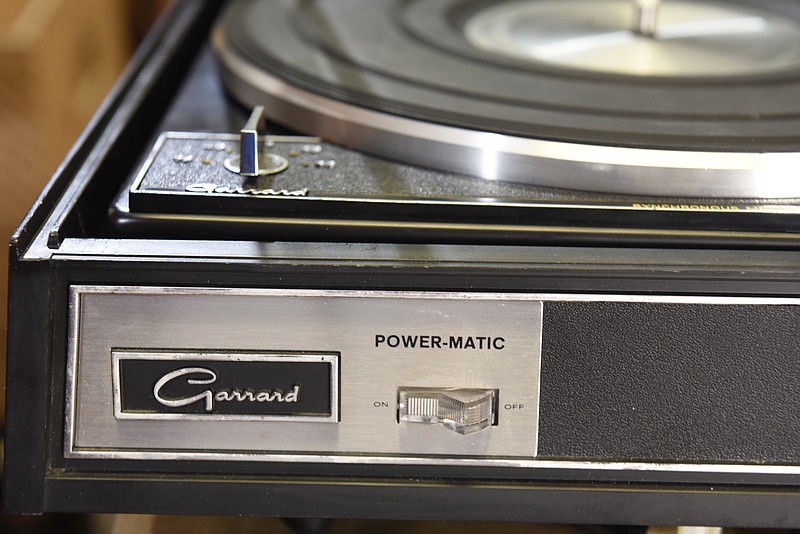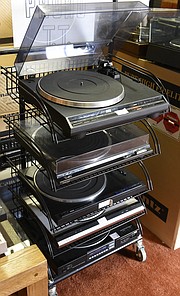What’s hot?
The Top 10 selling vinyl albums in 2015 included new releases and classics.1. Adele: “25” (116,000 copies)2. Taylor Swift: “1989” (74,000)3. Pink Floyd: “Dark Side of the Moon” (50,000)4. The Beatles: “Abbey Road” (49,800)5. Miles Davis: “Kind of Blue” (49,000)6. Arctic Monkeys: “AM” (48,000)7. Sufjan Stevens: “Carrie & Lowell” (44,900)8. Alabama Shakes: “Sound & Color” (44,600)9. Hozier: “Hozier” (43,000)10. Various Artists: “Guardians of the Galaxy Soundtrack” (43,000)Source: Forbes.com
Vinyl isn't just the name of a new series on HBO.
In fact, not only are those old records you have stored in the closet desirable and a little more valuable than you thought, so is that vintage turntable the albums are stacked on.
And while classic albums by Pink Floyd, The Beatles, Foreigner and Boston are the hardest to keep in stock for Chad Bledsoe at Chad's Records inside Winder Binder on the North Shore, the vinyl version of Adele's 2015 release "25" outsold all of them by a wide margin worldwide.
She sold 116,000 copies of her smash hit on wax alone. Besides Adele, Taylor Swift sold 74,000 vinyl copies of her "1989" album and Pink Floyd's "Dark Side of the Moon," which stayed on the Billboard charts from 1973 to 1988, was third on the Top 10 list, adding another 50,000 units sold last year to its total of 50 million copies sold since its release.
Vinyl album sales overall were up about 30 percent in 2015, at 12 millions records, according to Forbes.com. Albums started making a comeback five or six years ago when kids discovered mom and dad's stash of old records tucked away in the attic. Then it was about nostalgia and a certain hip factor related to doing something few others were doing. Now, it's about getting better sound.
"That is a very accurate statement," says Chris Kelly at For the Record in Northgate Mall.
"It sounds better," says D.B. Hall, owner of College Hi Fi Home Audio on Lee Highway.
Along with the richer sound, Kelly says people like having the actual album cover, with its printed information and graphics, to hold and study while the record is playing.
"A lot of people got tired of the mp3 formats and it being an invisible product," he says. "With vinyl, you have this 12-by-12-inch artwork and then you hear the deep, rich sound."
With vinyl's initial comeback, manufacturers started making relatively inexpensive turntables that would allow users to easily upload the records into digital versions for their mp3 players.
But even the most novice audiophile knows that squishing music into an mp3 defeats the whole beauty of listening to music on vinyl. Most digital music is compressed, meaning some of the sound - the parts engineers think humans can't hear anyway - is removed to make the music files smaller, digitally speaking.
And even if you don't use mp3s, Hall says listeners can hear the difference when they compare the same album on CD to vinyl.
Some newer records also are being released are on 180- or 200-gram versions and, while some contend the heavier record holds its sound better after being pressed, others say it's overkill and that all records, whether on 100-gram, 140-gram or 200-gram vinyl, are cut the same.
The record itself isn't all that matters when it comes to good sound reproduction. A quality, well-built turntable with a good cartridge - what many call the needle - also are important. And, of course, so are the amplifier and speakers.
At College Hi Fi Home Audio, Hall sells new and used stereo equipment, and he says the older turntables are better built and heavier, which helps control rumble and noise picked up by the needle.
He recommends older Denon, Audio-Technica, JVC and Pioneer models. They sell in his shop between $200 to $800, with most under $500.
You can spend far more, of course, on models with elaborate counterweights and tracking systems that look like something engineers at NASA designed. He also sells quality cartridges which range in price from $100 to $150.
In his shop, Hall repairs and services old turntables, making sure all the parts are clean, that it has a new belt, if it has one and isn't direct-drive, and that the tone arm and cartridge are properly tracked and balanced. Repairs start at $75, and involve a good cleaning and making sure things are working and set properly. It can cost more if parts need replacing.
On a day last week, Hall had 20 used turntables for sale. "I usually have about 10 used ones," he says.
He sells some to college-aged buyers, he says, but most turntables are going to middle-aged people who want the sound they grew up with.
There is little doubt that listening to music on CD or an mp3 player has its advantages, convenience being high among them. You load it, push play and get an hour or so of clean, hiss- and pop-free music.
With a record, there is a certain amount of commitment and involvement from the listener. It's more an experience, like enjoying a four-course meal where each bite is savored versus grabbing a power bar or fast-food meal on the run.
And there are certain steps that must be followed. First, remove the LP from inside the cover and paper sleeve; then clean the disc and maybe the needle; then, on some turntables, lift the tone arm and place it at the beginning of the album. And, of course, there is the act of getting up off the couch to flip the record over to side two when side one is finished.
Once that tone arm is down, most vinyl listeners don't cherry-pick favorite tracks because that means picking up the tone arm and moving it around. Because of that, they listen to the record in the sequence the artist intended.
But it is exactly those factors - as time-consuming and inconvenient as they may be - that a lot of people enjoy about the vinyl experience.
"If it wasn't for vinyl, I wouldn't have gotten so into so many great soul singers," says WDOD-FM/Hits 96 on-air personality Brad Steiner. "I wouldn't have found people like Little Ann, Wendy Rene, Solomon Burke or Baby Huey. With a record, it's a listening experience that you commit to. You discover the deep cuts. And it sounds better."
At For the Record, Kelly says new vinyl is about 25 percent of what he sells. New records cost about $17.98, but double albums and new releases can sell for $50.
At Chad Records, which has been around since 1988, Bledsoe deals mostly in used vinyl, He says the increase in sales has made it both harder to keep some LPs in stock and to find quality copies of what he's looking for. Bledsoe gets his inventory from record shows and individuals.
Those old Elvis records you have would be worth some cash if not for the "Bobby Loves Sue" or "Property of Tom" written across the cover or label. And never mind the big scratch on the vinyl itself.
"People either want to keep it or they want so much for it, and they don't always understand that it's in bad condition and that condition matters," Bledsoe says.
With the latest rise in interest in vinyl, values of desirable albums have increased as well, he says. Where he was asking a buck or two for a used Boston or Foreigner LP a few years ago, he's now getting $8, and they're gone as soon as he puts them in the bin.
The more rare albums - early Beatles, picture discs or special editions, for example - can fetch much more.
He's seen many trends in music come and go, but he's certain of one thing: "Classic rock is never going away."
Contact Barry Courter at bcourter@timesfree press.com or 423-757-6354.

